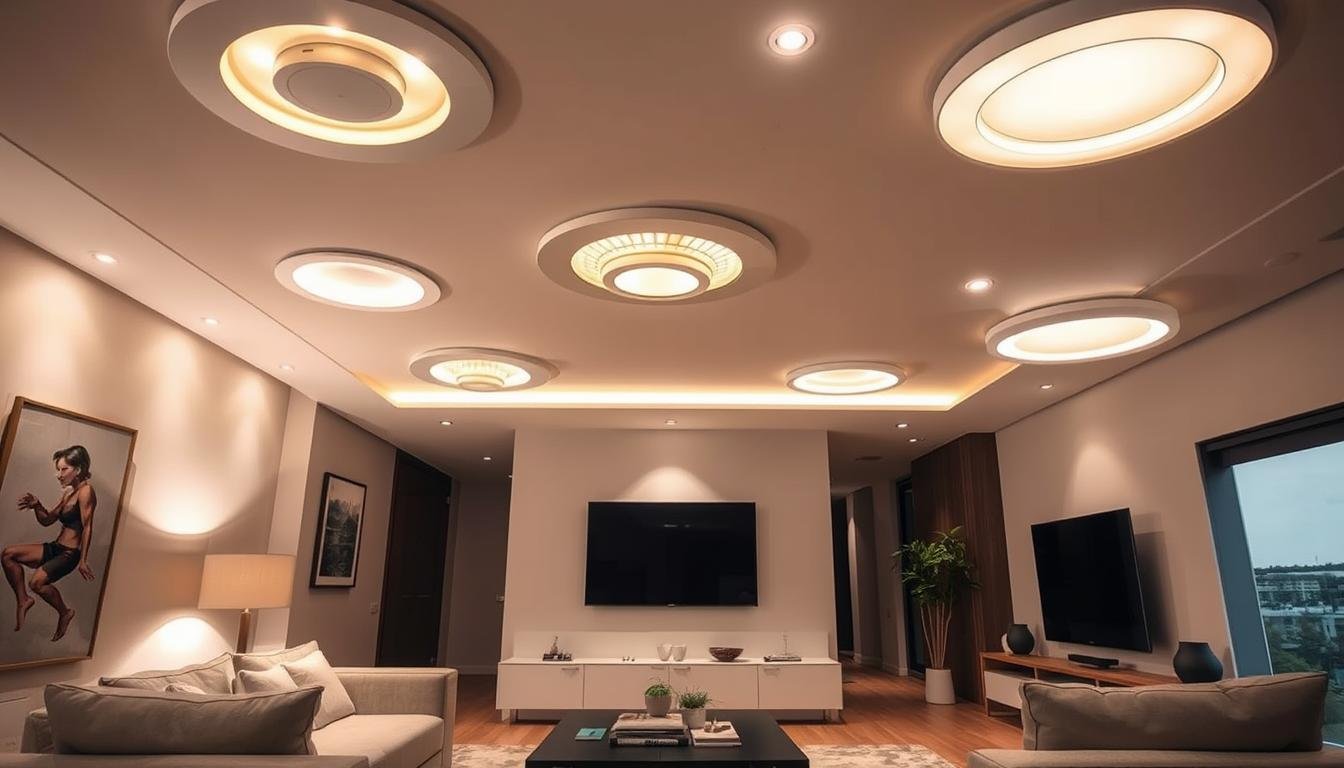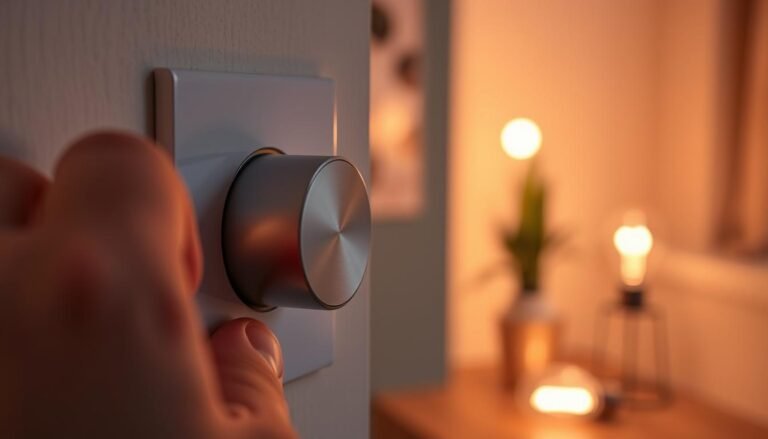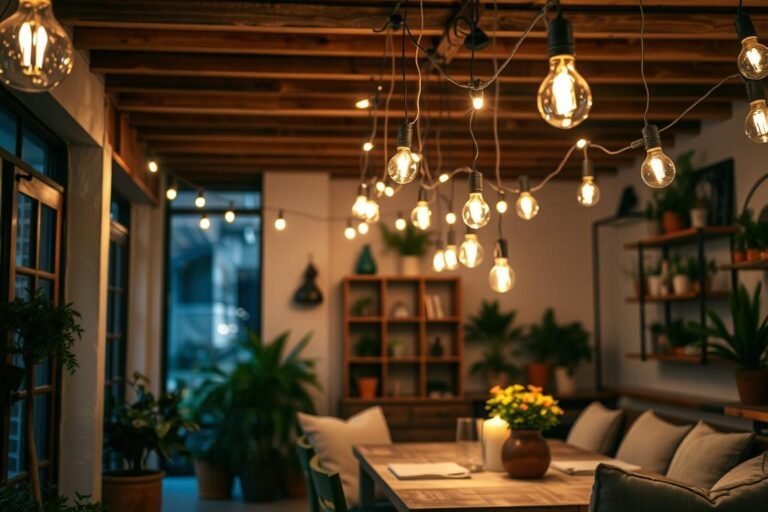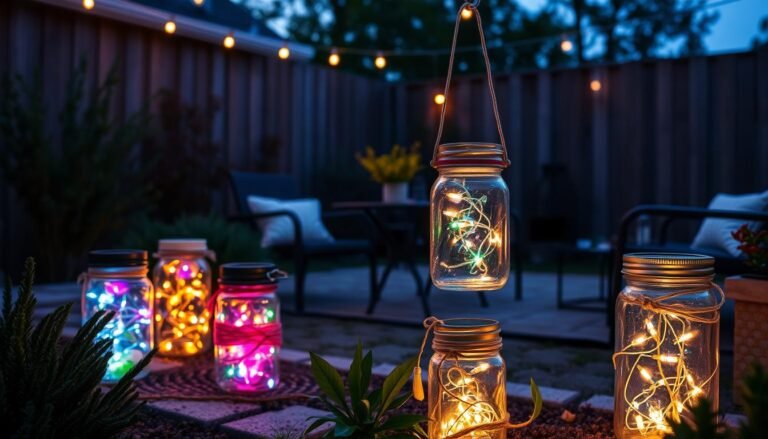Affiliate Disclosure: This post may contain affiliate links. If you make a purchase, we may earn a small commission at no extra cost to you.
Did you know the average American home has about 14 recessed lights? These ceiling fixtures, also known as can lights or downlights, are loved for their modern look and energy savings. They add a sleek, minimalist vibe to any room, making it brighter and more welcoming.
Recessed lighting fixtures fit into the ceiling. They sit inside, making them almost invisible from below. This type of lighting brings a clean, contemporary feel to any space. It comes in many shapes, sizes, and colors, offering lots of design choices.
However, using more than one light is key for the best light coverage. For the best look and function, it’s wise to get a pro to install them.
Key Takeaways
- Recessed or can lights, are a popular choice for modern, energy-efficient lighting in homes.
- These fixtures are installed into the ceiling, creating a sleek, minimalist look.
- Recessed lights offer various design options, but multiple lights are needed for optimal coverage.
- Professional installation is recommended for best results, as it can be a complex process.
- LED recessed lighting is a cost-effective and long-lasting choice, providing energy efficiency benefits.
Understanding Recessed Lighting Basics
Recessed lighting is a favorite for homes and businesses. It gives a sleek look that fits well with the ceiling. But, what makes it special, and what are its benefits and downsides? Let’s explore the basics of this versatile lighting option.
What Makes Recessed Lighting Different
Recessed lights are installed right into the ceiling. This makes it look clean and simple. The light is hidden, so it focuses on the area without being seen. There are different sizes, from small 4-inch to big 6-inch, for various needs and spaces.
Benefits and Limitations
Recessed lights are known for their clean look and flexibility. It works well with many decor styles and can highlight specific areas. But, it might need more than one light to light up a room well. Also, installing it can be trickier than other types of lights.
Key Components of Recessed Fixtures
Recessed lights have a few key parts. The housing holds the light in the ceiling. The light itself can be incandescent, halogen, CFL, or LED. The trim is the outer part that gives the light its look, from simple to fancy.
Learning about recessed lighting basics helps you make smart choices. It’s great for improving your home or business lighting. Recessed lights are both useful and stylish for different lighting needs.
Popular Recessed Lighting Housing Types
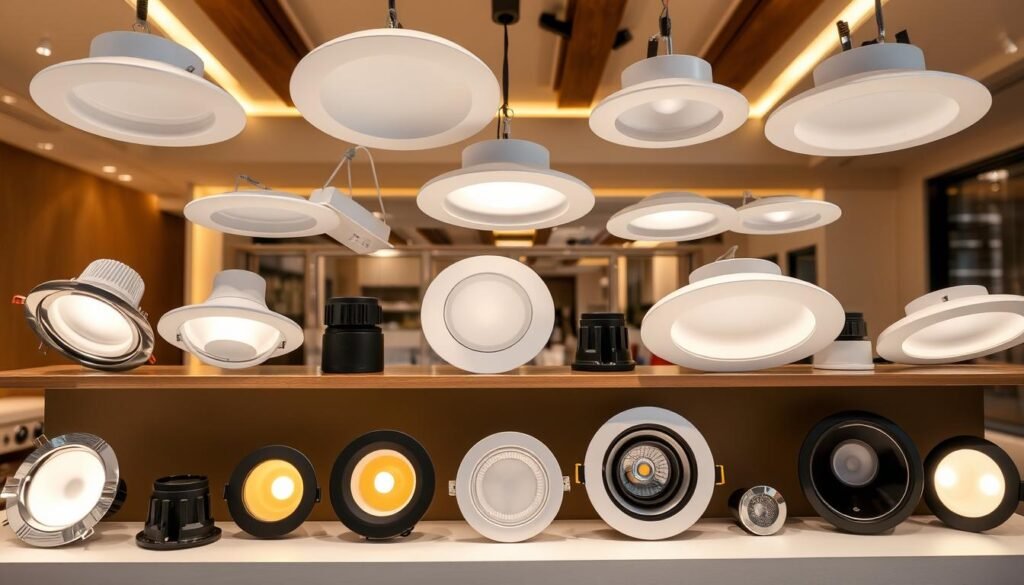
Choosing the right recessed lighting housing is key for your project’s look and function. There are two main types: new construction and remodel housings.
New construction housings need full access to the ceiling. They’re perfect for new homes or big renovations. Remodel housings, however, fit into existing ceilings with little access needed. They’re great for updating older homes.
Check out our FREE Calculators on our Resources Page
LED recessed lights with canless housings are also popular. They clip into the ceiling without extra wiring. Traditional can-style lights need more work to install.
Think about insulation when picking a housing. IC-rated housings work with insulation, while non-IC-rated ones are for uninsulated areas. This prevents overheating.
| Housing Type | Market Share | Key Features |
|---|---|---|
| New Construction | 44% | Ideal for new builds or major renovations, requires access to entire ceiling cavity |
| Remodel | 34% | Designed for retrofitting into existing ceilings, minimal access to studs or joists required |
| IC-Rated | 12% | Safe for use in insulated areas, prevent overheating |
| Non-IC Rated | 8% | Suitable for uninsulated spaces, without risk of overheating |
| Airtight | 2% | Emphasize energy efficiency by reducing air leaks between conditioned spaces |
Knowing about different housing types helps you choose wisely for your recessed lighting installation. This ensures your project goes smoothly and looks great.
Essential Trim Styles for Every Space
Recessed lighting’s trim is key for looks and function. It comes in many styles, from sleek to classic. Each one fits your taste and lighting needs.
Baffle and Reflector Trims
Baffle trims have a ribbed inside that softens light. They’re great for cozy areas like living rooms and bedrooms. Reflector trims, with their shiny surface, brighten up kitchens and high ceilings.
Adjustable and Wall Wash Options
For focused lighting, try adjustable trims like gimbal and eyeball. They’re perfect for highlighting features. Wall wash trims move freely, ideal for even wall lighting.
Specialty Trims for Unique Applications
Specialty trims meet specific needs. Shower trims are moisture-proof for bathrooms. Pinhole trims offer a sharp beam for modern looks. Open trims are simple and decorative trims add charm.
Every space has a recessed lighting trim that fits. Knowing your options helps create a beautiful lighting design. It makes your home look great.
| Trim Style | Application | Key Features |
|---|---|---|
| Baffle | Living rooms, bedrooms, entryways | Softens light with ribbed interior |
| Reflector | Kitchens, high-ceiling rooms | Amplifies light with polished surface |
| Adjustable (Gimbal, Eyeball) | Accent walls, sloped ceilings | Allows directional lighting control |
| Wall Wash | Artwork, even wall illumination | Offers a greater range of motion |
| Specialty (Shower, Pinhole) | Bathrooms, modern spaces | Designed for unique applications |
| Open | Cost-effective option | Low-profile, economical choice |
| Decorative | Add charm and character | Intricate patterns and designs |
Exploring recessed lighting design and trim lighting options helps you create a beautiful lighting scheme. It enhances your home’s look.
Choosing the Right Size and Placement
When installing recessed lights, the size and where you place your downlights matter a lot. The usual sizes range from 3 to 7 inches in diameter. For kitchen counters in 8-foot ceilings, 4-inch and 5-inch sizes work best.
The 6-inch housing is very popular for its versatility. To get even lighting, divide the ceiling height by two to find the distance between lights. Placing lights 3 feet from walls helps reduce shadows and makes the room brighter.
Positioning your recessed lights right can highlight important areas in your space. Use them to light up kitchen bars, bookshelves, and fireplaces. For task lighting, place them overhead in reading nooks, stovetops, and sinks. Think about the room’s use and ceiling height when picking the right size and layout.
FAQ
What is recessed lighting and how does it work?
What are the key components of recessed lighting?
What are the benefits and limitations of recessed lighting?
What are the different types of recessed lighting housing?
What are the various recessed lighting trim styles?
How do I choose the right size and placement for recessed lighting?
Check out our FREE Calculators on our Resources Page
Source Links
- Recessed Lighting Fixtures Explained – Sizes, Types, and Ratings – https://blog.recessedlighting.com/recessed-lighting-fixtures/
- What is recessed lighting? – https://lumenture.com/blog/recessed-lighting-the-basics/
- Top 5 Types of Recessed Lighting Trims – https://www.4servicepros.com/blog/types-of-recessed-lighting-trims/

